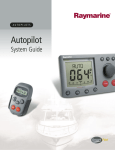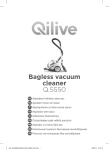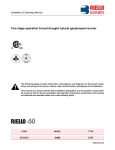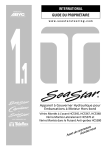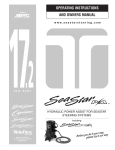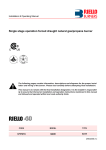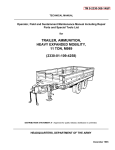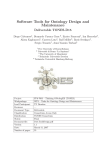Download Raymarine S100 Installation guide
Transcript
87040_5.book Page 1 Monday, April 30, 2007 5:58 PM SmartPilot S1000 Autopilot Installation Guide Document Number: 87040-5 Date: March 2007 87040_5.book Page 2 Monday, April 30, 2007 5:58 PM Welcome to the Raymarine S1000 Autopilot Congratulations on having bought a Raymarine S1000 Autopilot. This state-of-the-art product is specifically designed to be easily integrated with your boat’s steering system, and enable you to automatically control the steering. S1000 Autopilot System Existing hydraulic steering system S100 REMOTE S100 Remote MODE STANDBY PILOT Course computer GPS input Pump control Alarm signal Autopilot pump Safety alarm D7501-1 The S1000 requires GPS data (SeaTalk or NMEA compatible), to operate correctly The S1000 Autopilot is intended for use in: • HC5345, HC5347, HC5348, and HC5358 SeaStar steering systems. • Systems with HC4600, HC4645, HC4647, HC4648, and HC4658, BayStar steering rams. • Systems with Hynautic K6 steering rams. SeaTalk® is a Registered Trademark of Raymarine SeaStar® is a Registered Trademark of Teleflex Incorporated BayStar is a Trademark of Teleflex Incorporated NMEA® is a Registered Trademark of the National Marine Electronics Assocociation All other trademarks used in this document are acknowledged. © Copyright Raymarine UK Limited 2006 87040_5.book Page 1 Monday, April 30, 2007 5:58 PM S1000 Autopilot Installation Guide 1 Installation overview 1. Connect the autopilot pump to your existing steering system. Page 9 3. 4. 5. Bleed the steering system. Page 12 Secure the autopilot pump. Page 16 Fit the course computer. Page 17 Fit miscellaneous items Page 18 S100 Remote 6. 7. In-line power switch Safety alarm Make electrical connections Page 21 Carry out post installation checks Page 28 D7583-1 2. 87040_5.book Page 2 Monday, April 30, 2007 5:58 PM 2 S1000 Autopilot Installation Guide This guide Before starting to install your S1000 Autopilot, please take time to read this guide. In particular, please take note of the safety and electromagnetic compatibility (EMC) information at the end of this guide. WARNING: This product must be installed and operated in accordance with the Raymarine instructions provided. Failure to observe this could result in personal injury, damage to the boat and/or poor product performance. The installation procedures are described in a rational sequence, but because of variations in boat design, space available etc, you may need to adapt the sequence to suit your particular circumstances. Before you start fitting your S1000 Autopilot, we recommend you: • Unpack your S1000 Autopilot and check that all parts are present. • Plan your S1000 Autopilot installation so that you fit the components in the best possible locations. Important note The S1000 Autopilot must receive position information from a suitable GPS in order to function correctly. GPS systems compatible with SeaTalk or NMEA or both, are suitable. If you need advice as to which GPS to use, please contact your Raymarine dealer. 87040_5.book Page 3 Monday, April 30, 2007 5:58 PM S1000 Autopilot Installation Guide 3 What you need Parts supplied Elbow fitting, x 4 Autopilot Pump Straight fitting x 2 Anti-vibration mounts x 2 'T' fitting x 2 High pressure steering hoses (x 2) Low pressure transparent bleeding hose Nitrile gloves Wrench 12 mm AF x 19 mm AF Drill 3.4 mm Course Computer Safety alarm S100 REMOTE MODE STANDBY Drain cups PILOT Fill cups Belt clip assembly S100 Remote & 2 x cradles Connector block 1 pint (0.5 liter) hydraulic fluid Lanyard Power cable In-line power switch Ferrite D7330-2 Data cable Miscellaneous cable ties 87040_5.book Page 4 Monday, April 30, 2007 5:58 PM 4 S1000 Autopilot Installation Guide Tools & materials required Pencil Screwdriver, No. 2 Pozidriv Countersink bit Screwdriver, medium, flat blade Screwdriver, small, flat blade Absorbent, disposable wipes D7331-1 Drill 87040_5.book Page 5 Monday, April 30, 2007 5:58 PM S1000 Autopilot Installation Guide 5 Planning In order to make the installation as trouble free as possible, we strongly recommend you spend adequate time planning the best locations for your autopilot components. This is particularly important when considering the position of the autopilot pump, as hydraulic hoses are supplied in fixed lengths, so there are some limitations on the positioning of the autopilot pump with respect to the boat’s helm pump. If you have internet access, please view the installation video on line at www.raymarine.com. Before you disturb your hydraulic steering system, we strongly recommend that you consult the manufacturer and read the steering system manuals. Locating the course computer 5˚ 5˚ 5˚ 5˚ 5˚ 5˚ 5˚ At least 3 ft (1 meter) D7552-1 5˚ 87040_5.book Page 6 Monday, April 30, 2007 5:58 PM 6 S1000 Autopilot Installation Guide Locating autopilot pump Autopilot pump to be lower than helm pump. Install in a dry location. Provide protection from physical damage. Res e rv o Bleed S ir c re w Po R es e rv o rt Bleed S ir c re w Po rt Do not fit in engine compartments, near fuel tanks or in any other area where fuel vapor is likely. Mount pump location either horizontally or with connector end up. Do not mount pump with connector end down. D7350-1 No sharp bends, kinks or chafing of tube. 87040_5.book Page 7 Monday, April 30, 2007 5:58 PM S1000 Autopilot Installation Guide 7 Using the hydraulic hoses Three, pre-assembled hydraulic hoses are supplied. Two of these are dark-colored, high pressure steering hoses and the third is a transparent low-pressure hose. The transparent hose is intended to help you check for air bubbles when bleeding the system and must be used only to connect the autopilot pump reservoir to the lower connector on the helm pump. It must NOT be used anywhere else in the system. e Res Bleed S c w rv o re ir Po rt e Res Bleed c S c w rv o ir re w rv o re e Res Bleed S ir D7553-2 Po rt Po rt 87040_5.book Page 8 Monday, April 30, 2007 5:58 PM 8 S1000 Autopilot Installation Guide Sealing hydraulic joints CAUTION: Do not use sealing tape on any part of a hydraulic system, as this can disintegrate and the resulting particles can cause blockages in the hydraulic system. Tapered thread Do not apply sealant to hose connection thread. Note: The hydraulic fittings supplied with the autopilot pump have sealant preapplied to the tapered threads. You only need to apply sealant to any extra joints you may obtain. The recommended sealant for doing this, is Loctite 542. D7545-1 Thread for hose connection Installing tapered thread fittings 1. Hand tighten 2. CAUTION: Do not exceed 13 ft/lbs (17.6 Nm) torque. 1.5 turns From hand tight, use a wrench to tighten the joint a further 1.5 turns. This should make it leakproof. CAUTION: Do not exceed 13 ft/lbs (17.6 Nm) torque. DO NOT EXCEED 2.5 TURNS in total, from hand tight. To change the orientation of the joint to align it with the hose, further tighten the joint, to a maximum of one further turn, until the joint is facing the required direction. D7546-1 3. 87040_5.book Page 9 Monday, April 30, 2007 5:58 PM S1000 Autopilot Installation Guide 9 Installation procedures 1. Connecting the autopilot pump O Connecting the autopilot pump, sheet 1 WARNING: Do not allow hydraulic fluid to come into contact with your skin. Wear the protective nitrile gloves provided when working with hydraulic fluid. WARNING: A sudden release of pressure from a hydraulic system could result in personal injury. Before disconnecting any part of a hydraulic steering system, safely release any pressure in accordance with the manufacturer’s instructions. WARNING: The autopilot pump is not suitable for use in the vicinity of engines, fuel tanks or in any other area where fuel vapor is likely to be present. CAUTION: Do not use the transparent hose for connecting any part of the steering system other than between the autopilot pump reservoir and the lower connector on the helm pump. 1. Secure the required hydraulic joints (elbow or straight) into the autopilot pump, as described under Installing tapered thread fittings. 2. Connect the hydraulic hoses to the autopilot pump. Ensure the transparent hose is connected to the reservoir connector. Reservoir connector Starboard connector e Res Bleed S c w rv o re ir Po rt Res e rv o S ir c re w rt Po Port connector D7345-1 Bleed 87040_5.book Page 10 Monday, April 30, 2007 5:58 PM 10 S1000 Autopilot Installation Guide 0 Connecting the autopilot pump, sheet 2 3. Set steering to dead ahead and do not move it until instructed. 4. Remove & retain the helm pump breather cap. 5. Remove & retain the plug from the helm pump lower connector, and drain the fluid into one of the cups provided. Discard the drained fluid in accordance with local regulations. reassembly, then disconnect both ram hoses & straight connectors from the helm pump. Using the Installing tapered thread fittings procedure, fit 'T' connectors to the helm pump port and starboard connectors, and a straight connector to the helm pump lower connector. D7483-1 D7483-2 7. 6. Label the port ram hose to aid future 87040_5.book Page 11 Monday, April 30, 2007 5:58 PM S1000 Autopilot Installation Guide 11 Connecting the autopilot pump, sheet 3 8. Connect hydraulic steering hoses from autopilot pump Port and Starboard connectors to the Port and Starboard connectors on the helm pump, so that Port connects to Port, and Starboard connects to Starboard . 9. Re-connect the ram hoses to the appropriate helm pump 'T' connectors. to steering ram e Res Bleed S c w rv o re ir Po rt e Res Bleed S c w rv o re ir Po rt 10. Connect the transparent hose from autopilot pump reservoir hose to the straight connector at the helm pump lower connector. This completes the connection of the autopilot pump. Now bleed the steering system. e Res Bleed S c w rv o re ir D7484-2 Po rt 87040_5.book Page 12 Monday, April 30, 2007 5:58 PM 12 S1000 Autopilot Installation Guide 2. Bleeding the steering system WARNING: Do not allow hydraulic fluid to come into contact with your skin. Wear the protective nitrile gloves provided when working with hydraulic fluid. Connecting the autopilot pump will introduce air into the steering system, making it feel ‘spongy’ and ‘lumpy’ to operate. To return the steering system to smooth operation, use the procedure given here to bleed the air from the system. Bleed procedure, sheet 1 1. Top up the helm pump with hydraulic fluid. 2. Loosen the autopilot pump bleed screw 2 full turns. e Res Bleed S c w rv o re ir D7336-1 Po rt 87040_5.book Page 13 Monday, April 30, 2007 5:58 PM S1000 Autopilot Installation Guide 13 Bleed procedure, sheet 2 3. Using a suitable screwdriver, turn the autopilot pump shaft so that the flat on the shaft is toward the PORT side of the pump. 4. SLOWLY turn the wheel counter-clockwise and observe the bubbles in the transparent tube. Keep the helm pump reservoir topped up while doing this. Keep turning the wheel counter-clockwise until there are no more bubbles i.e. so the hydraulic fluid in the transparent tube is clear. c re w ir ir Po rt D7339-2 w rv o re rv o e Res Bleed c e Res Bleed S S Po rt 87040_5.book Page 14 Monday, April 30, 2007 5:58 PM 14 S1000 Autopilot Installation Guide Bleed procedure, sheet 3 5. Using a suitable screwdriver, turn the autopilot pump shaft so that the flat on the shaft is toward the starboard (STBD) side of the pump. 6. SLOWLY turn the wheel clockwise and observe the bubbles in the transparent tube. Keep the helm pump reservoir topped up while doing this. Keep turning the wheel counter-clockwise until there are no more bubbles i.e. so the hydraulic fluid in the transparent tube is clear. c re w ir ir Po rt D7337-2 w rv o re rv o e Res Bleed c e Res Bleed S S Po rt 87040_5.book Page 15 Monday, April 30, 2007 5:58 PM S1000 Autopilot Installation Guide 15 Bleed procedure, sheet 4 7. Top up the hydraulic fluid. Correct fluid level Helm pump 8. Turn the autopilot pump bleed screw, fully clockwise, and hand-tighten it. e Res Bleed S c w rv o re ir Po rt 9. Replace the helm pump breather cap. D7486-1 This completes the bleed procedure. Now secure the pump. 87040_5.book Page 16 Monday, April 30, 2007 5:58 PM 16 S1000 Autopilot Installation Guide 3. Securing the pump Securing the pump 1. Place the pump at the intended location and mark holes for the fixing screws. 3. Countersink the pilot holes to prevent damage to the mounting surface. 2. Drill two 1/8" (3.4 mm) pilot holes for the fixing screws. 4. Slide the anti-vibration mounts onto the pump bracket feet, then secure the pump with the screws provided. e Res Bleed S c w rv o re ir Po rt e Res Bleed S c w rv o re ir Po rt D7488-2 When the autopilot pump is secure, fit the course computer. 87040_5.book Page 17 Monday, April 30, 2007 5:58 PM S1000 Autopilot Installation Guide 17 4. Fitting the course computer Securing course computer 1. Mark holes for fixing screws. 2. Drill two 1/8" (3.4 mm) pilot holes for fixing screws. 3. Countersink the pilot holes to prevent damage to the mounting surface. 4. Partially screw in the screws provided, then slot the course computer onto the screws, and tighten screws. D7338-1 The course computer is now secure. 87040_5.book Page 18 Monday, April 30, 2007 5:58 PM 18 S1000 Autopilot Installation Guide 5. Fitting miscellaneous items Safety alarm Locating Securing 1. Mark holes for fixing screws. 2. Drill two 1/8" (3.4 mm) pilot holes. 3. Countersink the pilot holes to prevent 4. Secure the safety alarm with the screws provided. D7607-1 damage to the mounting surface. Fitting batteries in S100 Remote When replacing, use only high-quality alkaline, AAA size batteries. D7504-2 2 x AAA batteries (supplied). 87040_5.book Page 19 Monday, April 30, 2007 5:58 PM S1000 Autopilot Installation Guide 19 Fitting S100 Remote cradle At fixed position 1. Mark holes for the fixing screws. On belt clip 1. 2. Drill three 1/8" (3.4 mm) pilot holes for the fixing screws. 2. 3. 3. Countersink the pilot holes to prevent damage to the mounting surface. To separate cradle from clip D7683-1 4. Secure the cradle. ck Cli 87040_5.book Page 20 Monday, April 30, 2007 5:58 PM 20 S1000 Autopilot Installation Guide In-line power switch Locating Fit the in-line power switch in a readily-accessible location. Securing 1. 2. Cut 11/16" (18 mm) 1/ inch 5 (5 mm) maximum Ensure the protrusion on the switch barrel goes fully into the mounting hole. 3. 4. D7591-1 5. [ When all items have been fitted, connect up the system electrics. 87040_5.book Page 21 Monday, April 30, 2007 5:58 PM S1000 Autopilot Installation Guide 21 6. Electrical connections Overview Summary WARNING: Before making electrical connections to any part of the S1000 system, ensure the power source for the system is switched off. Course Computer e Res Bleed S c w rv o re ir Po rt RF ground Autopilot Pump See Diagram A See Diagram B In-line power switch See Diagram B NMEA Spur Alarm SeaTalk See Diagram C & Diagram D See Diagram C See Diagram C D7522-1 Data cable 87040_5.book Page 22 Monday, April 30, 2007 5:58 PM 22 S1000 Autopilot Installation Guide Connecting wires When you need to join wires, use the either the supplied Scotchlock connectors or terminal block, as appropriate. D7547-1 Note: Scotchlock connectors are suitable for joining thin, data wires. They are NOT suitable for connecting the safety alarm. S1000 Autopilot Grounding The S1000 Autopilot system requires an RF ground connection to be made, to ensure complete conformance with the EU regulations requirements AFTER installation. The RF ground connection is also essential to maintain the electromagnetic performance of the system in all installations, regardless of local regulations requirements (world wide). Failure to provide an RF ground when the S1000 Autopilot is installed could result in a degraded electromagnetic performance and may affect the operation of the system. The recommended MINIMUM requirement for an RF ground lead is: • Flat, tinned copper braid, 0.25 inch (6.5 mm) width minimum. Equivalent stranded wire diameter 0.16 inch (4 mm) 87040_5.book Page 23 Monday, April 30, 2007 5:58 PM S1000 Autopilot Installation Guide 23 Diagram A: Connecting RF ground - preferred method Course computer S1000 Autopilot 0191O Product Code: A18107 POWER PUMP FCC ID PJ5S1000 IC: 4069B-S1000 Raymarine Ltd Portsmouth PO3 5TD England If the boat does not have a ground plate, use the alternative method shown in the following diagram, to connect the RF ground. Boat hull RF Ground Plate Alternative method Note: Use this method of connecting the terminal, ONLY if the boat does not have an RF grounding plate. When using this method, do NOT connect the terminal to any other point. Course computer S1000 Autopilot 0191O Product Code: A18107 A18107 Product Code: POWER PUMP FCC ID PJ5S1000 IC: 4069B-S1000 Raymarine Ltd Portsmouth PO3 5TD England D7539-2 Now connect the power & the autopilot pump. 87040_5.book Page 24 Monday, April 30, 2007 5:58 PM 24 S1000 Autopilot Installation Guide Diagram B: Connecting power & autopilot pump Course computer S1000 Autopilot 0191O Product Code: A18107 POWER PUMP FCC ID PJ5S1000 IC: 4069B-S1000 Raymarine Ltd Portsmouth PO3 5TD England Brown Integral 10 A fuse Black 12 V Power supply Blue Integral ferrite Red Autopilot pump Now make the necessary Data Cable connections. D7541-1 In-line power switch 87040_5.book Page 25 Monday, April 30, 2007 5:58 PM S1000 Autopilot Installation Guide 25 Diagram C: Connecting the Data Cable Course Computer GPS requirement The S1000 must receive GPS information to function correctly. Use the Data Cable supplied, to connect the Course Computer to a GPS, using either of the following methods: 1. To a Raymarine GPS via SeaTalk connections. 2. To a Raymarine GPS via NMEA spur. 3. To a non-Raymarine GPS via NMEA spur. Data cable NMEA connector (not supplied), from GPS NMEA Spur When connecting NMEA data from an external source, always connect via the NMEA spur on the Data Cable. Do NOT connect NMEA data from an external source directly to the connector on the Course Computer. For details of the NMEA Spur connections, refer to Diagram D Each time power is applied to an S1000 Autopilot connected to a Raymarine GPS (via NMEA or SeaTalk), the S1000 will set the GPS filtering to WEAK. Purple White Connector block Red Black Safety alarm Yellow: SeaTalk Data Red: SeaTalk +12 V Black: SeaTalk 0 V SeaTalk If you want to connect to an external SeaTalk system, ensure each of these SeaTalk wires connects to the wire of the same color in the external system. When you have completed the electrical connections, secure the wires at the Course Computer. D7549-1 Clip ferrite to Data Cable, as close to the connector as possible 87040_5.book Page 26 Monday, April 30, 2007 5:58 PM 26 S1000 Autopilot Installation Guide Diagram D: NMEA connections Course Computer Using with Raymarine GPS If a Raymarine GPS (such as the Raystar 120 or 125) is to be connected to the S1000 Autopilot via NMEA, the NMEA in and out, +ve and -ve lines must all be correctly connected. Each time power is applied to an S1000 Autopilot connected to a Raymarine GPS (via NMEA or SeaTalk), the S1000 will set the GPS filtering to WEAK. Pin 1 NMEA Connector Pin 2 NMEA Spur Pin 3 Pin 5 CAUTION: Before making any changes to the Data Cable, disconnect it from the Course Computer. Data cable If it is more convenient to connect the NMEA spur to the GPS without using the NMEA connector, you can remove the connector and prepare the cable end as appropriate for your preferred method of connection. Refer to the wire identification table below, as necessary SeaTalk & safety alarm connections (see Diagram C) Pin number 1 2 3 5 NMEA signal at S1000 -- ve out +ve out +ve in -- ve in Connection at 3rd party GPS NMEA --ve receive NMEA +ve receive NMEA +ve transmit NMEA --ve transmit When you have completed the electrical connections, secure the wires at the Course Computer. D7596-1 Wire color Brown Green Orange Blue 87040_5.book Page 27 Monday, April 30, 2007 5:58 PM S1000 Autopilot Installation Guide 27 Secure wires Course Computer PUMP D7551-1 POWER This completes the installation procedure. Now carry out the Post installation procedures (below). 87040_5.book Page 28 Monday, April 30, 2007 5:58 PM 28 S1000 Autopilot Installation Guide 7. Post installation When you have completed the installation of your S1000 Autopilot, use the following procedures to: • First carry out the Manual checks below, to check the the steering operation and check the system for leaks, then • Carry out the Autopilot checks & setup procedures below, to check the autopilot operates the steering in the correct direction, and to set up the autopilot correctly. Manual checks With autopilot power off, turn the wheel from hard over port, to hard over starboard. If the steering operates satisfactorily and turns in the correct direction, proceed with the other post installation checks. If the steering feels uneven and/or less responsive than it was before you installed your S1000 Autopilot, you may need to bleed the entire steering system. To do this, use the purge procedure at the following web address: http://www.seastarsteering.com/OUTBOARD/oboard.htm?../FILL_PURGE/FillPurge.htm&1 Check for leaks (sheet 1) 1. Ensure all hydraulic joints are secure, then turn the wheel to port. When the hard over point is reached, continue turning to port to pressurize the port lines, until the safety valve releases. At this point, the fluid in the port lines will be at maximum pressure and the wheel has a 'lumpy' feel when turned further to port. 2. With the port lines at maximum pressure, check the port lines for leaks, paying particular attention to the joints. If a leak occurs, turn the wheel to starboard to release the pressure, then repair the leak and repeat steps 1 & 2. D7502-1 Continue on sheet 2 87040_5.book Page 29 Monday, April 30, 2007 5:58 PM S1000 Autopilot Installation Guide 29 Check for leaks (sheet 2) 3. Turn the wheel to starboard, and when the hard over point is reached, continue turning to starboard to pressurize the starboard lines, until the safety valve releases. At this point, the fluid in the starboard line will be at maximum pressure and the wheel has a 'lumpy' feel when turned further to starboard. 4. With the starboard lines at maximum pressure, check the starboard lines for leaks, paying particular attention to the joints. If a leak occurs, turn the wheel to port to release the pressure, then repair the leak and repeat steps 3 & 4. 5. After 24 hours, re-check the steering system to D7550-1 ensure there are still no hydraulic fluid leaks. Autopilot checks & setup WARNING: Before switching on power to the course computer, make sure that personnel are clear of the steering gear and outboard motor(s), and that the boat is securely moored. 1. Switch on power to the S1000 system. 2. Carry out the Checking direction of turn procedure (below). Checking direction of turn - sheet 1 Before casting off, check that the S1000 operates the boat's steering system in the correct direction: At the S100 Remote, hold down STANDBY for 2 seconds, to enter Setup mode. SETUP Continue on sheet 2 D7704-1 1. 87040_5.book Page 30 Monday, April 30, 2007 5:58 PM 30 S1000 Autopilot Installation Guide 2. Hold down < and > in turn, and as each of these is pressed, ensure that the outboard motor(s) turn(s) to give the correct direction of steer. 3. If the outboard motor(s) does/do not move correctly, DO NOT USE THE BOAT. At the S100 Remote, hold down STANDBY for 2 seconds to leave Setup mode and return to Standby mode, then check that the S1000 components have been installed correctly. In particular, check that the autopilot pump wiring and hydraulics are connected correctly. D7705-2 Checking direction of turn - sheet 2 87040_5.book Page 31 Monday, April 30, 2007 5:58 PM S1000 Autopilot Installation Guide Specifications System Approved by: FCC (USA), CE (Europe), IC (Canada) Autopilot pump Current consumption: 4 A at 100 psi (69 kP), 7 A at 500 psi (3449 kP) Dimensions: 6.5 in (165 mm) x 2.5 in (65 mm) x 3.2 in (82 mm) Weight: 3 lbs (1.4 kg) Course computer Voltage: 10 V dc to 16 V dc Current consumption: 4 A nominal, with autopilot pump running Dimensions: 6.5 in (165 mm) x 6.7 in (170 mm) x 1.73 in (44 mm) Data In/Out: SeaTalk, NMEA 0183 S100 Remote Voltage: 3 V, supplied by two internal, ‘AAA’ batteries. Dimensions: S100 Remote only: 101 mm x 60.5 mm x 35 mm Remote in cradle:103 mm x 66 mm x 44 mm Waterproofing: IPX 6 and IPX 7 Hydraulic fittings Tapered thread: ¼ NPT (National Pipe Thread) Hose connection thread: 9/16 UNEF (Unified Extra Fine) Hydraulic fluid Recommended Type: SeaStar/BayStar Marine Steering Fluid Other suitable Types: Texaco HO15 Shell Aero 4 Esso Univis N15 Chevron Aviation Fluid A Mobil Aero HFA Fluids meeting MIL H5606 specifications 31 87040_5.book Page 32 Monday, April 30, 2007 5:58 PM 32 S1000 Autopilot Installation Guide General Information Safety notices WARNING: Product installation & operation This equipment must be installed and operated in accordance with the Raymarine instructions provided. Failure to do so could result in personal injury, damage to your boat and/or poor product performance. WARNING: Electrical safety Make sure you have switched off the power supply before you start installing this product. Information To the best of our knowledge, the information in this guide was correct when it went to press. However, Raymarine cannot accept liability for any inaccuracies or omissions it may contain. In addition, our policy of continuous product improvement may change specifications without notice. Therefore, Raymarine cannot accept liability for any differences between the product and this guide. EMC Installation Guidelines All Raymarine equipment and accessories are designed to the best industry standards for use in the recreational marine environment. Their design and manufacture conforms to the appropriate Electromagnetic Compatibility (EMC) standards, but correct installation is required to ensure that performance is not compromised. Although every effort has been taken to ensure that they will perform under all conditions, it is important to understand what factors could affect the operation of the product. The guidelines given here describe the conditions for optimum EMC performance, but it is recognized that it may not be possible to meet all of these conditions in all situations. To ensure the best possible conditions for EMC performance within the constraints imposed by any location, always ensure the maximum separation possible between different items of electrical equipment. For optimum EMC performance, it is recommended that wherever possible: • Raymarine equipment and cables connected to it are: • At least 3 ft (1 m) from any equipment transmitting or cables carrying radio signals e.g. VHF radios, cables and antennas. In the case of SSB radios, the distance should be increased to 7 ft (2 m). • More than 7 ft (2 m) from the path of a radar beam. A radar beam can normally be assumed to spread 20 degrees above and below the radiating element. • The equipment is supplied from a separate battery from that used for engine start. Voltage drops below 10 V in the power supply to our products, and starter motor transients, can cause the equipment to reset. This will not damage the equipment, but may cause the loss of some information and may change the operating mode. • Raymarine specified cables are used. Cutting and rejoining these cables can compromise EMC performance and must be avoided unless doing so is detailed in the installation manual. • If a suppression ferrite is attached to a cable, this ferrite should not be removed. If the ferrite needs to be removed during installation it must be reassembled in the same position. 87040_5.book Page 33 Monday, April 30, 2007 5:58 PM S1000 Autopilot Installation Guide 33 Suppression Ferrites The following illustration shows typical cable suppression ferrites used with Raymarine equipment. Always use the ferrites supplied by Raymarine. D3548-6 Connections to Other Equipment If your Raymarine equipment is to be connected to other equipment using a cable not supplied by Raymarine, a suppression ferrite MUST always be attached to the cable near the Raymarine unit. 87040_5.book Page 34 Monday, April 30, 2007 5:58 PM 34 Raymarine UK Ltd, Quay Point, Northarbour Road Portsmouth, Hampshire PO6 3TD, United Kingdom. Tel: +44 (0) 23 9269 3611 Fax: +44 (0) 23 9269 4642 www.raymarine.com S1000 Autopilot Installation Guide Raymarine Inc, 21, Manchester Street, Merrimack, New Hampshire 03054-4801, USA. Tel: +1 603.881.5200 Fax: +1 603.864.4756 www.raymarine.com




































